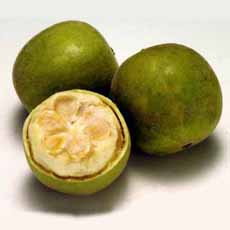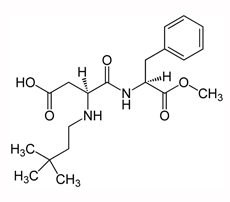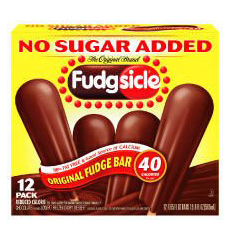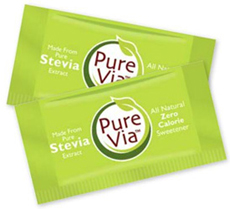Glossary Of Natural & Artificial Non-Caloric SweetenersPage 9: Glossary Of Artificial Sweeteners L To R This is Page 9 of an 11-page article. Click on the red links below to visit other pages. This glossary is protected by copyright and cannot be reproduced in whole or part. You are welcome to link to it.
|
 Maltitol, one of the most sugar-like of the sugar alcohols. Photo courtesy SHChemGroup.com. |
|
|
An asterisk (*) indicates a natural product, i.e., one derived principally from a plant or other natural product. See monk fruit, below.
|
||
|
LOW-CALORIE SWEETENERS Low-calorie sweeteners—including zero-calorie sweeteners—provide a sweet taste with few or no accompanying calories. Before being approved by the FDA for use in the United States, sweeteners must undergo extensive safety testing. All FDA-approved low-calorie sweeteners meet the same standard of safety and are safe for consumption by pregnant women and children. Six low-calorie sweeteners currently are approved for use in the United States: acesulfame potassium (Ace-K), aspartame, neotame, saccharin, sucralose, and tagatose. The FDA is considering petitions to approve alitame and cyclamate, both of which have been approved for use in numerous other countries.
|
 Photo composition by Jade Gordon | SXC. |
|
|
MALTITOL* Maltitol is a polyol (sugar alcohol) made by hydrogenation of maltose obtained from starch. It is considered to be the best substitute for sucrose. Maltitol has approximately 90% of the sweetness of sugar but just half the calories—2.1 calories per gram as opposed to 4.0 calories per gram for sugar (i.e., it reduces calories by 12% to 15%). Its high sweetness allows it to be used without being mixed with other sweeteners. It gives creamy texture to food, so it can be also used to replace fat. It works especially well in the production of sugarless sweets: chocolates, hard candies, baked goods, confections and ice cream. High-end manufacturers also use it in chewing gum, but because it is a more costly product, many manufacturers use other sweeteners. Maltitol is made from both corn and wheat. The wheat-derived product is said to be of higher quality, in that it causes less gastric distress when consumed in quantity (see sugar alcohol for details). Maltitol is also known under its trade names Maltisorb® and Maltisweet®. MANNITOL*
|
 Cookies made with maltitol. You can buy them online. Photo courtesy Charleston Cookies. Read our review. |
|
|
MONKFRUIT* A natural sweetener made from the extract of a small Asian melon, lo han kuo (also spelled lo han guo and luo han kuo, botanic name Siraitia grosvenorii), a sweetener derived from the fruit has been used as a sweetener in China and Southeast Asia for generations. It is 200 to 250 times as sweet as table sugar. A low glycemic index makes it appropriate for diabetics. It is very stable under high temperature and thus suitable for cooking and baking. It is currently labeled a dietary supplement by the FDA. NATURLOSE* |
 Monkfruit, or lo han kuo. Photo by Kasuga Huang | Wikimedia. |
|
|
NEOTAME Neotame, made by NutraSweet, is an artificial non-caloric sweetener and flavor enhancer with a clean, sweet, sugar-like taste. In 2002, it was granted approval by FDA for use in baked goods and desserts, carbonated soft drinks and other beverages, candies, chewing gum and yogurt and pudding-type products. It is the sweetest of all products, measure for measure about 8,000 times sweeter than sugar. Neotame is a synthetic derivative of a combination of aspartic acid and phenylalanine—the same two amino acids that are used to make aspartame. Neotame is more stable than aspartame for cooking and baking. Unlike aspartame, neotame isn’t broken down in the body into the amino acid phenylalanine, which is toxic to people with the phenylketonuria (PKU). It is rapidly metabolized and completely eliminated. The FDA Acceptable Daily Intake is 18 mg per kg.† As of this writing, there are no consumer products available in the U.S., due to the recency of neotame’s FDA approval. If this sounds like time enough as of this January 2009 update, note that the petition to the FDA was filed in 1997. Only after the products was approved five years later, did manufacturers begin to think of testing it in products, substituting neotame for their current non-caloric sweeteners. It takes years of product development, consumer testing and then limited test markets before a manufacturer will risk a roll-out. According to the December 2008 issue of Dr. Janet Starr Hull’s “Alternative Health & Nutrition” newsletter, a number of beverages have “recently” been introduced in Australia and New Zealand, where neotame was approved in August 2001. Here’s how Neotame compares to other sweeteners. †FDA-established acceptable daily intake (ADI) limit per kilogram (2.2 pounds) of body weight. Product consumption equivalent for a 150-pound person.
|
 The chemical structure of Neotame. Image courtesy Jü | Wikimedia. |
|
|
NO SUGAR ADDED This is not the same as sugar-free; while No Sugar Added products may not contain table sugar (sucrose), they substitute other naturally-occurring sugars such as dextrose, maltose, fructose, sorbitol or lactose. All of these are simple carbohydrates that can raise blood sugar levels, and they have calories. See sugar-free. POLYOLS*
|
 No sugar has been added, but the product may still contain natural sugars from other ingredients. Photo courtesy Unilever. |
|
|
PUREVIA* Pepsico’s branded, zero-calorie sweetener made from rebiana, a compound found in the leaves of the the stevia plant. PureVia is an all natural zero calorie sweetener made from the pure, sweet extract of the stevia plant. Its main sweetening ingredient is Rebaudioside A, commonly known as “Reb A,” a high-purity extract that is the sweetest component of the stevia plant.
|
 PureVia, a brand of stevia-based sweetener made by the producers of Equal. You can buy it online in bulk or in packets. Photo courtesy Merisant Company. |
|
|
REBIANA* A compound in the leaves of the stevia plant. In July 2007, Coca-Cola and Cargill corporations announced that they had been jointly developing a new low-calorie sweetener, with the working name Rebiana. In December 2008, federal regulators approved two branded versions of rebiana-based sweeteners. Cargill is marketing the sweetener Trivia from Coca-Cola; PepsiCo’s branded rebiana-based sweetener is called PureVia. RICE MALT |
 A field of stevia plants, source of rebiana. Photo courtesy Trent Schneid. |
|
Last Updated Jun 2018
© Copyright 2005-2025 Lifestyle Direct, Inc. All rights reserved. All images are copyrighted to their respective owners.